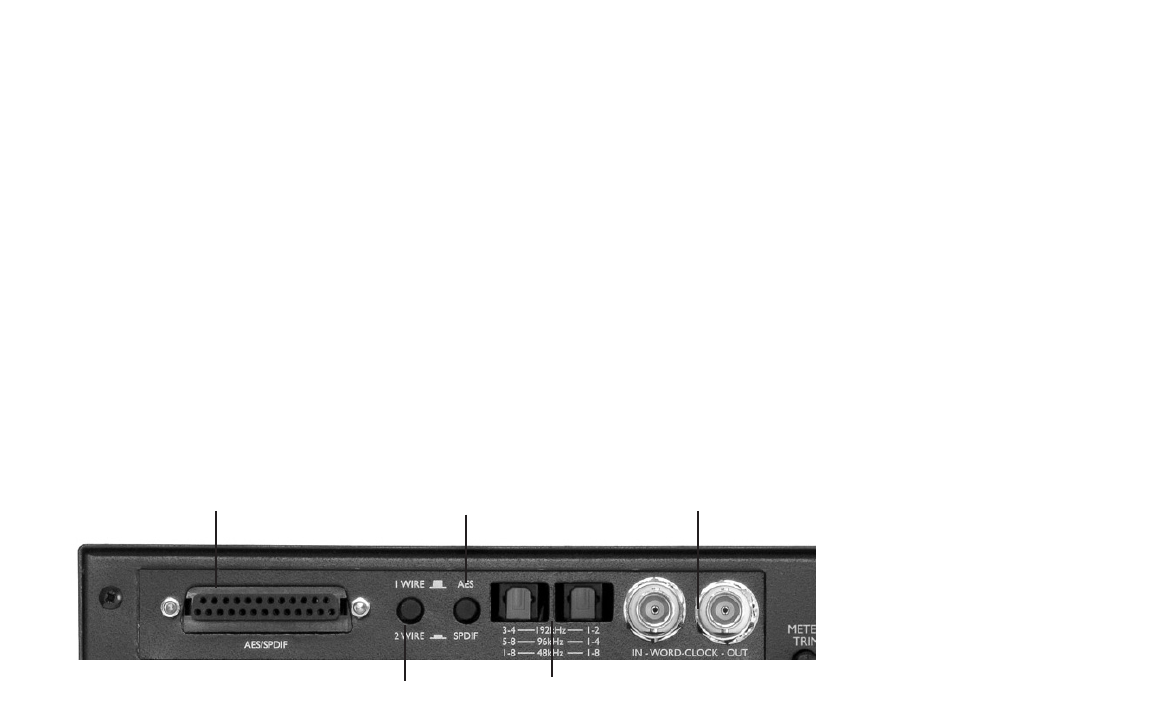
IEC mains inlet
This socket allows the supplied IEC cable to be connected to enable the 828 to be powered. A fused voltage selector
is also present, with a diagram alongside to indicate the positions that relate to each voltage.
Optional digital card connections
The remaining connections (if present) are those on the optional digital card and are explained fully in the next section.
Digital Options
The optional ADC can be retrofitted to a standard ISA 828 at any time. No engineering experience is required as the
card can be fitted easily by the user. Full fitting instructions for this option are included along with the ADC.
Digital Outputs (AES, S/PDIF)
A 25-pin (Tascam DB-25FM) connector allows up to 8 channels of 24-bit digital audio (AES or S/PDIF) to be transmitted
to a DAW or other digital storage medium. The card can be configured using jumpers (on the card) and using two push
button switches on the rear panel. The table on page 11 shows the pinout details for all available configurations. Below
is a brief description of the overall functionality available.
Jumper position
The digital card has four jumpers (movable plastic clips) that can be positioned so as to disable AES outputs 5-8, and
therefore make the 828 pin to pin compatible with a Pro Tools HD™ 192 interface using a standard 25-pin to 25-pin cable.
With the jumpers in the disabled position (default), channels 1-8 are available at 44.1-96kHz and channels 1-4 at
176.4/192kHz. Depending on the position of 1-wire/2-wire switch. (See Appendix 1 for details of the cable pinout for
recording all 8 channels to Pro Tools™ at 192kHz - jumpers are enabled in this case.)
AES, S/PDIF switch
This switch selects whether the signal is professional (AES) or consumer (S/PDIF) digital format. With the switch out,
channels 1-8 are in AES format and are duplicated across the connector, allowing 16 outputs (dependent on wire mode
switch). With the switch in, channels 1-8 are available as S/PDIF and AES formats (number of channels available in AES
format is dependent on wire mode switch). See the table on page 11 for pinout details.
1-Wire/2-Wire AES mode switch
For sample rates from 88.2 to 192kHz, a dual-wire mode is available for connecting to older equipment with AES
inputs, which can only receive speeds up to 192kHz by using both digital channels of a single AES connection (known
as ‘2-wire’). Engaging this switch ‘splits’ the digital signal and activates dual wire mode, which means that half the
number of channels are transmitted down the same number of wires. Transmitting channels 1-8 in 2-wire mode
requires all of the pins of the DB25 connector. Therefore, if the S/PDIF mode is selected, only channels 1-4 can
be transmitted as AES format. (See the table on page 11 for pinout details.)
Selects 1-wire or 2-wire mode for
connecting a 176.4 or 192kHz AES
signal to older equipment
AES, S/PDIF Outputs 1-8,
25-pin, D-type
Selects AES (switched out)
or S/PDIF (pressed in)
Word Clock In and Out, BNC connectors
ADAT™ Outputs, 1-8 across both @
44.1/48kHz, 1-4 then 5-8 @ 88.2/96kHz
and 1-4 @ 176.4/192kHz
10


















